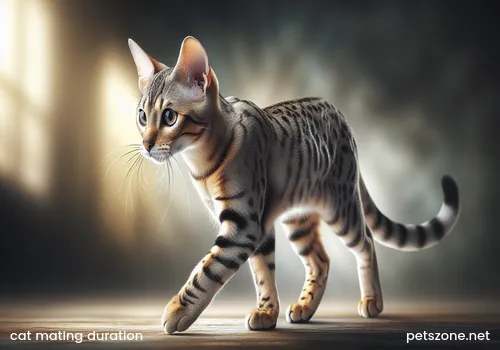How Long Does Cat Mating Take_Disclosing the Entire Mating Process
It may seem counterintuitive, but for cats, the legendary "love-making" moment is actually shockingly brief—usually just a few seconds, rarely exceeding 20 seconds. However, within this extremely compressed time lies the pinnacle of evolutionary efficiency and a highly complex, even "painful yet pleasurable" biological mechanism.
If you have been fortunate (or unfortunate, depending on your tolerance) enough to observe a cat's estrus and mating process, you will notice it is not as tender or lingering as in humans or some other mammals. A cat's courtship period may last a while, with tomcats chasing and howling, and the female cat giving unique calls, writhing, rolling on the ground, showing clear signals of acceptance or rejection. But once the female truly enters the receptive state, allowing the male to approach and mount, everything happens in a flash.
This process can be roughly broken down into several key stages, each filled with the wonders of nature's design:

Stage One: Warm-up and Acceptance Signals
This is the "slowest" part of the whole process. The female cat enters estrus (scientifically called "proestrus" and "estrus"), proclaiming her condition through scent (urine, secretions), vocalizations (the unique "cat calling"), and body language. She may become unusually affectionate or restless, roll on the ground, arch her back and raise her rear (known as the "lordosis reflex" or "queen posture", indicating readiness to mate). Tomcats are attracted by these signals, start circling her, emitting low growls, sometimes trying to approach and sniff. The female may immediately accept or show defensive postures, hissing or swiping claws. It is a process full of probing and negotiation. Only when the female poses the classic low crouch, forelegs on the ground, hindquarters raised, does it indicate she is fully ready.
Stage Two: The Critical Seconds—Mating Moment
Once the female assumes the posture, the tomcat quickly moves forward, placing his forelegs on the female’s waist and biting the skin on her neck (usually to hold and control, sometimes thought to trigger a stronger mating reflex). Then, copulation occurs. Note this is the shortest but biologically most critical part of the whole process. From mounting to ejaculation, it takes place within these lightning-fast seconds.
Why so brief? This relates to cats’ unique physiological structure and reproductive strategy. The tomcat's penis is covered with barbs (keratinized spines), which scrape the female’s vaginal walls and cervix as it withdraws. This is crucial as it directly leads to the next stage.
Stage Three: The Dramatic Finale—Post-Mating Reaction
This is probably the most "impressive" part of the cat mating process. After ejaculation and withdrawal, the female usually emits a sharp, mournful howl—some sound like pain, others like extreme discomfort. Then, she immediately turns to attack the tomcat, chasing and biting, forcing him to quickly flee the scene. The tomcat’s reaction can be summed up in one word: dash! He scrambles away to keep a safe distance, licking himself and panting.
After driving off the tomcat, the female does not calm down immediately. She begins wildly rolling on the ground, often convulsing, then spends a considerable amount of time licking her vulva, cleaning and stimulating it. Compared with the brief mating itself, this behavior is more intense and prolonged.
Stage Four: Refractory Period and Preparations for Next
After this "storm," the tomcat and queen enter a brief refractory period. They separate and ignore each other. The tomcat needs time to rest before mating again, and the female needs time to recover from the stimulation. However, this refractory period doesn’t last long. Within one estrous cycle, the female might show acceptance signals again after a few hours or a day, ready for another mating round. The estrus period can last several days or even over a week, during which the female may mate multiple times, even with different males.
The Biological Principle Behind: Induced Ovulation
Now, let's explain why the whole process is arranged this way, especially those few seconds, the barbs on the penis, and the female's intense post-mating reaction. It all points to one key concept: cats are induced ovulators.
Unlike spontaneous ovulators like humans (whose ovaries release eggs cyclically regardless of sexual activity), female cats' ovaries usually do not ovulate spontaneously during estrus. Ovulation requires external stimulation—the primary trigger is the scratching and mechanical stimulation of the vaginal walls by the male’s barbed penis during mating. This mechanical stimulus sends nerve signals to the hypothalamus and pituitary, triggering the release of luteinizing hormone (LH), causing follicle rupture and egg release.
With this understanding, everything makes sense:
* Short mating duration: likely an expression of efficiency. Once ovulation stimulation and ejaculation are done, there’s no need to remain exposed longer—the sooner it ends, the less risk.
* Barbs on the penis: the core "tool" for the induced ovulation mechanism. Without these barbs providing stimulation, ovulation in females would be difficult.
* Female’s post-mating reaction: the howl, attack, rolling and licking are believed to be neurologically and endocrinologically linked to ovulation. The intense stimulation and discomfort trigger hormone release.
Thus, the female’s "painful" or "uncomfortable" post-mating reaction is not just emotional stress, but a necessary physiological process to initiate ovulation—a sophisticated (albeit potentially uncomfortable) mechanism evolved to ensure reproductive success.
A Broader Perspective: Reproductive Efficiency and Cost
The strategy of induced ovulation and multiple matings greatly increases the chances of pregnancy during one estrous cycle. A female mating with multiple males in the same cycle ensures enough stimulation to induce ovulation and increases the genetic diversity of her offspring, advantageous for survival in the wild.
However, for domestic cats, this high reproductive efficiency means populations can rapidly increase if not controlled (i.e., spayed or neutered), leading to stray cat issues and challenges to individual health. Frequent estrus and pregnancy take a heavy toll on the female’s body, and unspayed cats are more prone to certain reproductive diseases.
From a practical viewpoint on platforms like Zhihu, understanding cats' mating process and biology helps us coexist better with cats, making responsible decisions. Knowing the physiological basis of estrus clarifies their sometimes puzzling behaviors; understanding the "pain points" of mating highlights spaying’s importance in relieving physiological stress.
In summary, a cat's mating process is a highly condensed event rich in biological uniqueness. It’s far more than those few seconds of physical contact, involving complex signaling, instant behaviors based on special physiology, and a series of physiological reflexes designed to ensure reproduction. These brief moments and ensuing reactions embody millions of years of evolutionary wisdom bestowed upon the cat family. Next time you see a cat in heat, perhaps you’ll feel more understanding and less troubled.
-560x560.webp)

